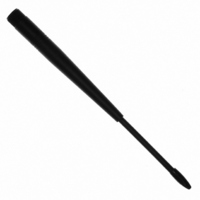0600-00027 Laird Technologies, 0600-00027 Datasheet - Page 17

0600-00027
Manufacturer Part Number
0600-00027
Description
ANTENNA 915MHZ 1/2WV 7" RPSMA
Manufacturer
Laird Technologies
Specifications of 0600-00027
Antenna Type
Whip: 1/2 Wave, Swivel, Tilt (Right Angle)
Number Of Bands
1
Frequency
902MHz ~ 928MHz
Vswr
2
Gain
2dBi
Termination
RP-SMA
Mounting Type
Connector
Height (max)
8.25" (209.5mm)
Impedance
50 Ohms
Technology Type
1/2 Wave Wireless Transceiver Antenna
Termination Style
RPSMA
Lead Free Status / RoHS Status
Lead free / RoHS Compliant
Lead Free Status / RoHS Status
Lead free / RoHS Compliant, Lead free / RoHS Compliant
R
Random Back Off – The transceivers utilize a Carrier Sense Multiple Access (CSMA) protocol with random back off and a selectable
back-off seed. Therefore, in the event of a collision, the transceiver will back off and retry the packet. Specifically, when two
transceivers detect a collision, each transceiver will choose a random number of packet times that it will wait before retrying the
packet. This random number is selected from a pool of numbers defined by the back-off seed and consists of a number between 1
and 2, 1 and 4, 1 and 8, 1 and 16, 1 and 32, 1 and 64, 1 and 128 and 1 and 256. In a very dense network, where more than two
transceivers could experience a collision, it is important to have a higher random back-off seed.
S
System ID – System ID (EEPROM address 0x76) is similar to a password character or network number and makes network
eavesdropping more difficult. A transceiver will not establish a Session or communicate with another transceiver on a different
System ID or Channel Number.
RF Channel Number – Channels 0x00-0x0F and 0x30-0x37 only use 26 hops. Channels 0x10 – 0x2F use 50 hops. Other than that
Channel Number (EEPROM address 0x40) can be considered as another byte of System ID.
**All channels in a channel set hop on the same frequencies only in a different order.
DES (Data Encryption Standard) – Encryption is the process of encoding an information bit stream to secure the data content. The
DES algorithm is a common, simple and well-established encryption routine. An encryption key of 56 bits is used to encrypt the
packet. The receiver must use the exact same key to decrypt the packet; otherwise garbled data will be produced.
YSTEM
ANDOM
WHAT EFFECTS WILL RANDOM BACK OFF HAVE ON SYSTEM LATENCY?
As the Random Back Off value increases, the overall latency also increases.
RF Channels 0x00-0x0F
•
•
Quick Tip:
Worst Case Latency (Half Duplex) = 50 ms Hop * Number of Retries * Maximum Random Value
Worst Case Latency (Full Duplex) = 100 ms Hop * Number of Retries * Maximum Random Value
ID/RF C
B
ACK
0 (AC4790-1x1,
1 (AC4790-1x1,
2 (AC4790-1x1,
Channel Set
AC4790-200)
AC4790-1000)
AC4790-200,
AC4790-1000)
O
HANNEL
FF
RF Channel Number Range
N
Table 8 - RF Channel Number Settings
UMBER
0x00 – 0x0F
0x10 – 0x2F
0x30 – 0x37
Figure 4 - RF Channel Numbers
(0x40)
RF Channels 0x10-0x2F
915 – 928 MHz (22 Hop Bins)
902 – 928MHz (26 hop bins)
902 – 928MHz (50 hop bins)
Regulatory Requirements
Frequency Details and
RF Channels 0x30-0x37
(-1x1/-200/-1000)
US/Canada
US/Canada
US/Canada
(-1x1/-200)
Countries
Australia
17




















